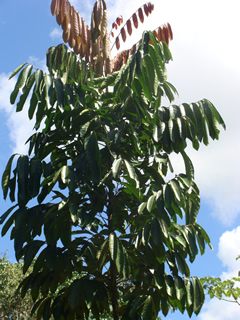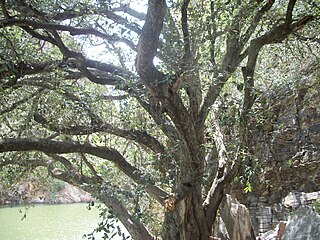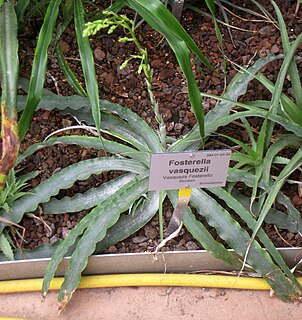
Carapa is a genus of flowering plants in the mahogany family, Meliaceae. These are trees up to 30 meters tall occurring in tropical South America, Central America, and Africa. Common names include andiroba and crabwood.
Licania fasciculata is a species of plant in the family Chrysobalanaceae endemic to Panama. It is threatened by habitat loss.

Licania is a genus of over 200 species of trees and shrubs in the family Chrysobalanaceae. Species are found naturally occurring in Neotropical forests from southern Mexico to Brazil and the Lesser Antilles. Due to increased deforestation and loss of habitat, several species have declined, some markedly so, and L. caldasiana from Colombia appears to have gone extinct in recent years. Many species are either rare or restricted in distribution and therefore potentially threatened with future extinction.

Faramea is a genus of plant in the family Rubiaceae.
Licania caldasiana is an extinct species of plant in the family Chrysobalanaceae. It was endemic to Colombia The Licania plants is classified into a family called the, Chrysobalanaceae” which has over 200 different kinds of species other than just the Licania Caldasiana. Licania Caldasiana is found in very tropical areas, including the southern part of the world between the Mexico and Columbia area.
Licania chiriquiensis is a species of plant in the family Chrysobalanaceae. It is endemic to Panama. It is threatened by habitat loss.
Licania conferruminata is a species of plant in the family Chrysobalanaceae. It is endemic to Brazil.
Licania grandibracteata is a species of plant in the family Chrysobalanaceae. It is endemic to Ecuador. Its natural habitat is subtropical or tropical moist montane forests.
Licania hedbergii is a species of plant in the family Chrysobalanaceae. It is endemic to Ecuador. Its natural habitat is subtropical or tropical moist montane forests.
Licania longicuspidata is a species of plant in the family Chrysobalanaceae. It is endemic to Ecuador. Its natural habitats are subtropical or tropical moist lowland forests and subtropical or tropical moist montane forests.
Licania megalophylla is a species of plant in the family Chrysobalanaceae. It is endemic to Ecuador. Its natural habitat is subtropical or tropical moist montane forests.
Licania morii is a species of plant in the family Chrysobalanaceae. It is endemic to Panama.
Licania salicifolia is a species of plant in the family Chrysobalanaceae. It is endemic to Colombia.
Licania splendens is a tree in the family Chrysobalanaceae. The specific epithet splendens is from the Latin meaning "shining", referring to surfaces of the dried leaves.
Licania velutina is a species of plant in the family Chrysobalanaceae. It is endemic to Ecuador. Its natural habitat is subtropical or tropical moist lowland forests.

Licania rigida, the oiticica, is a species of plant in the family Chrysobalanaceae. It is endemic to Brazil and Puerto Rico. The oiticica grows deep in floods of rivers and streams, forming long, narrow avenues to the edge of ravines or floodplains staining the dark-green color of its large and dense foliage.

Fosterella vasquezii is a plant species in the genus Fosterella. This species is endemic to Bolivia.
Puya vasquezii is a species in the genus Puya. This species is endemic to Bolivia.




